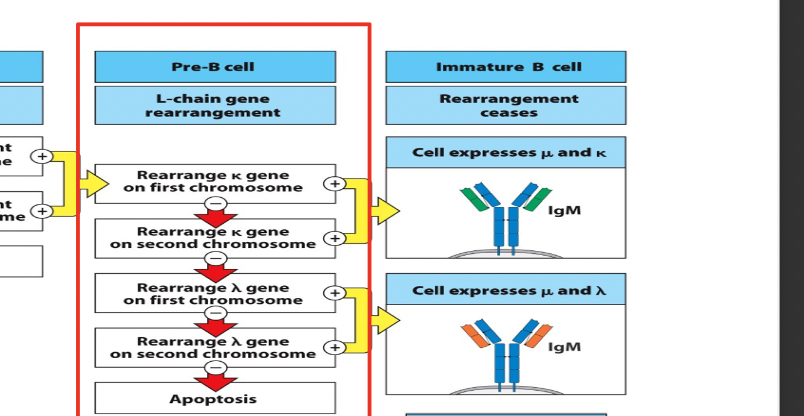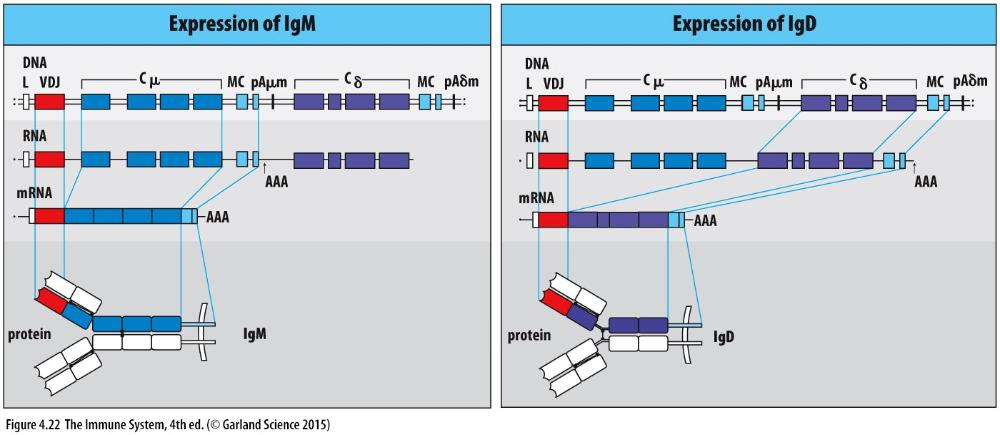Describe the general steps by which VDJ recombination occurs in the immunoglobulin genes during B cell development in the bone marrow.
Phase 1-6
Phase 1: (Bone Marrow)
- Generation of diverse and clonally expressed B-cell receptors in the bone marrow
- Repertoire Assembly
Phase 2: (Bone Marrow)
- Alteration, elimination or inactivation of B-cell receptors that bind to components of the human body
- Negative Selection
Phase 3: (2nd Degree Lymphoid Tissue)
- Promotion of a fraction of immature B cells to become mature B cells in the secondary lymphoid tissues.
Describe the reasons for a non-productive heavy chain or light chain gene rearrangement.
Non-productive:
- A non-productive rearrangement of DNA can occur if the open reading frame comprised of the codons that define the sequence of a functional light chain or heavy chain protein are disrupted either by a frame shift mutation or by the insertion of a stop codon.
- Based on the mechanism of somatic recombination, these problems would occur at V/J junctions of light chain DNA, or at V/D or D/J junctions of heavy chain DNA.
- IG alpha and IG beta: memorize these
Explain how multiple attempts can be made to productively rearrange the light chain genes.
Explain why multiple rearrangement attempts cannot occur for heavy chain genes
Light Chain:
Heavy Chain:
- Describe the protein composition of the pre-B cell receptor.
- Describe the function of the various components of the pre-B cell receptor.
- Explain the processes that occur after signaling through the pre-B cell receptor (1st checkpoint).

- H
- hf
- After the 1st checkpoint you get a immature B cell. From the kappa genes the cell expressed µ and kappa. From lamba genes the cells expressed µ and λ.
Describe the protein composition of the B cell receptor.
Describe the function of the various components of the B cell receptor.
Describe the processes that occur after signaling through the B cell receptor (2nd checkpoint).
Composition of B cell receptor:
Functions of receptors:
Process after signaling:
Explain why autoreactive B cells are produced.
Explain why some autoreactive B cells are able to leave the bone marrow and escape negative selection in that tissue.
Autoreactive produced:
Ability to leave (Neg. Selection):
Explain the processes that account for central tolerance, and negative selection of autoreactive B cells.
Central Tolerance and Neg. Selection
Describe the process of B cell rescue, also referred to as receptor (immunoglobulin) editing.
Process of receptor editing:
Explain the difference between central tolerance and peripheral tolerance, with respect to treatment of autoreactive B cells.
Central Tolerance:
Peripheral Tolerance:
Describe the properties/behavior of an anergic B cell.
Properties:
Explain what a recently released B cell (from bone marrow) must accomplish if it is to have a reasonably long life in the body.
Explain the role that entry into lymphoid follicles (present within secondary lymphoid tissues) plays in this process.
Must accomplish...
Role of role that entry into lymphoid follicles...
True/False: VDJ rearrangement of a single heavy chain locus is more likely to be non-productive than a VJ rearrangement of a single light chain locus.
True
Every recombination is risky
light chain has less opportunity to fail and heavy chain has more opportunity to fail
We just learned that if the first rearrangement of a light chain gene is non-productive, the same gene can undergo a second (successive) gene rearrangement in an effort to be productive. True/False : A single heavy chain gene can also undergo successive rearrangements if the first recombination attempt is non-productive (refer to image above for guidance).

False
There is just one left after VDJ.

The image shows the mechanism for how a single naive B cell expresses both IgM and IgD isotypes at the same time (fact). True/False: Expression of IgD (right hand side of image) requires a DNA recombination event similar to what occurs during class-switching.
False
A newly developed B cell in the bone marrow expresses an immunoglobulin that binds to an epitope on a self protein that is expressed by skin cells. Which one of the following processes is most likely to occur to this cell?Select an answer and submit. For keyboard navigation, use the up/down arrow keys to select an answer.
a.)Cell fails negative selection and dies by apoptosis in the bone marrow.
b.) Cell undergoes a process called receptor editing.
c.)Cell migrates to a secondary lymphoid tissue to complete the process of positive selection.
d.)Cell fails negative selection and becomes anergic (non-responsive) in the bone marrow.eThe cell changes from a B cell into a T cell.
c.)Cell migrates to a secondary lymphoid tissue to complete the process of positive selection.
True/False: The process of B cell negative selection most likely evolved to eliminate B cells that express low affinity immunoglobulins
False
A B cell developing in the bone marrow produces a pre-B cell receptor and a B cell receptor (fact). Which one of the following statements about these receptors is false?
a.) Both receptors contain an immunoglobulin heavy chain protein.
b.) After their formation, each receptor initiates a signal transduction pathway within the cell.
c.)Both receptors play a role in allelic exclusion.
d.)Both receptors bind to the same antigen.
e.)Only one of these receptors plays a role in negative selection.
d.)Both receptors bind to the same antigen.
B cells must successfully pass two checkpoints in order to successfully produce an immunoglobulin on their surface (fact). True/False: It is possible for the cell to pass checkpoint #1 even if it does not complete a productive rearrangement of a light chain gene.
True
Which one of the following B cell developmental processes does not occur in the bone marrow?
a.)Recombination of V and J segments.
b.)Positive selection.
c.) Allelic exclusion.
d.)Negative selectioneRearrangement of D and J segments.
b.)Positive selection.
Some individuals suffer from a condition called MHC-II deficiency. Cells of these individuals express little to no MHC-II. True/False: The thymus of individuals suffering from MHC-II deficiency produce fewer CD4 expressing T cells than a normal individual.
true
Which one of the following processes does not occur during T cell development in the thymus?
a.Elimination of self-reactive cells by apoptosis.
b.Testing the affinity of TCR for self MHC/peptide.
c.Activation of tissue-specific genes by a transcription factor called AIRE.
d.Reprogramming some cells into Tregs.
e.Clonal expansion of pathogen-specific T cells following infection.
e.Clonal expansion of pathogen-specific T cells following infection.
True/False: A developing T cell can fail positive selection or it can fail negative selection, but it cannot fail both.
True
A developing T cell in the thymus fails positive selection and is induced to die by apoptosis. True/False: This T cells was demonstrated to be autoreactive.
false
A developing T cells passes checkpoint 1 but fails to pass checkpoint #2. True/False: This T cell is more likely to be reprogrammed into a Treg than other cells that do pass checkpoint #2.
FALSE